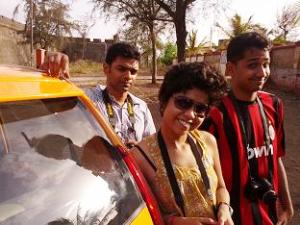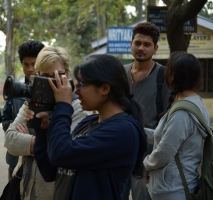There's no such thing as "mere entertainment". To dismiss films as "mere entertainment" would be both superficial and naive!
As I sat down to write this piece, I happened to read an earlier cover story in The Thumb Print magazine by Los Angeles-based writer and teacher Toby Miller. The article was about Hollywood's hegemony across the world and how American films have proved to be roving ambassadors for American culture worldwide.
There are probably those who will dismiss Mr Miller as a conspiracy theorist. However, there's no denying the fact that Hollywood's global dominance has helped the US both politically and economically, upped its glamour quotient and therefore the value of anything it creates, generated enormous goodwill for the country and a sub-conscious trans-national interest in its goods. Among other things, our consumption of American films and TV serials here in India now dictates the way we casually slip into jeans as everyday wear, it largely explains how teenagers many continents away use "like" in their sentences more often than the definite article, and it nudges us in the direction of brands hitherto unseen on our shop shelves when they first arrive on our shores, all in a way that goes beyond our national worship of all things Western or white.
On a smaller scale, Bollywood is to India what Hollywood is to the world. Let's rewind briefly to politician Abu Azmi being manhandled in the Maharashtra Assembly by Maharashtra Navnirman Sena MLAs because he chose to take his oath in Hindi instead of the language of the state, Marathi. What can be objectionable about using "the national language", he countered? Without for a second endorsing MNS' abhorrent violence, I'd like to ask: what "national language"? Hindi is an "official language" of the Union followed by English. Considering that India does not have a Constitutionally recognised "national language", how has it come about that most of India (the so-called national media included) is under the impression that Hindi holds that exalted position? The answer is manifold: first, as members of the media and the public we tend to be casual about facts; second, Hindi is spoken by larger sections of our population than any other Indian language; and third, let's not ignore the role of North India-centric parties who understand, as all propagandists do, that a lie repeated a hundred times becomes the truth. But most of all, the answer is Bollywood.
The fact is that the Hindi film industry has been able to do for the Hindi language what no amount of political imposition could have possibly achieved. The popularity of Hindi film stars transcends state borders in this country. The devotion to Rajinikanth within Tamil Nadu may have no match in other states across the country, but any honest list of stars with a pan-India presence today would undoubtedly be dominated by Hindi film stars. The result is a greater familiarity with Hindi even in non-Hindi-speaking states.
So the truth is that our films have a far stronger influence on our psyche than any academic paper submitted in a university, certainly far more than we would like to admit. The truth is too that, in one way or another, every film is a reflection of the film maker's thoughts and beliefs, and no film can be taken lightly. Take Homi Adajania's recently released Cocktail that positions itself as a liberal film. When I wrote on my blog about the regressive values it perpetuates, the manner in which it slots women as the 'cool type' and the 'traditional type', its shockingly retrograde portrayal of single women and the insidious stereotype of the heroine with the Christian name who smokes, drinks, takes drugs and sleeps around while the pronouncedly-Hindu Meera is the name given to the second heroine who does not smoke, does not drink, does not take drugs and does not appear to have sex, I was flooded with responses on Twitter and Facebook. Many agreed with me, but most assured me that I was over-reacting and/or that I should "chill" and "relax" because after all "it's just a film".
Is there such a thing as "just a film"? Those who think so need to seriously reflect on the good or harm that any film can do. They must also ask themselves why political parties routinely harass the makers of films if they amount to "mere entertainment". Let's face it … The fact that word-of-mouth and media reviews of Cocktail were largely positive is a reflection of the widespread acceptance of the stereotypes projected by the film. "Par aisi ladkiyaan aise hi toh hoti hai," said a lady in my very upmarket gym in a very upmarket part of this city, when I mimicked the manner in which Deepika Padukone's very desperate Veronica goes to pieces because she is rejected by the man she loves. QED.
This, of course, is the point I'm trying to make throughout my newly released book The Adventures of an Intrepid Film Critic (Om Books International). On the face of it, the book is my account of a year in which I decided to blog reviews of every single Hindi film released in the entire National Capital Region, big or small, known or unknown, hyped or unhyped, promoted or unpromoted … unfettered by office-determined deadlines and space constraints. Through the experience of critiquing those 121 films and tracking down the people who made even the most obscure ones among them, I ended up with an overview of the Hindi film industry as it is today. To be honest with you though, Bollywood in particular and films in general have just been my excuse to look at a bigger picture.

Bollywood's shortcomings and strengths, its political stances and sociological apathy are nothing but a reflection of the society from which industry members are drawn. And so, a discussion in the book on the National Award-winning 2011 film I Am becomes an opening to delve into the avoidance of the Kashmir issue by the Hindi film industry, no different from the national disinterest in the plight of Kashmiri Pandits. In that story, the readers of this website could draw parallels with the pan-India indifference to the concerns of the seven sister states of the Northeast. It's no coincidence that the people of Assam, Arunachal Pradesh, Meghalaya, Mizoram, Manipur, Nagaland and Tripura get nary a mention in Hindi cinema. After all, in spite of M.C. Mary Kom's victory at this year's Olympics, the fact is that most people in the rest of the country would be hard pressed to name the state she belongs to; in spite of the recent rumour-mongering targeting people of the North East working outside their home states, the geography and culture of this part of the country is still far from the so-called "national" radar.
When Vidya Balan and Priyanka Chopra discuss the position of women in Hindi films in The Adventures of an Intrepid Film Critic, if you nip a sentence here and tuck a sentence there, you would find their views equally relevant to several other Indian film industries. Transpose their words to another setting and they could well be discussing the problems that women face in any profession anywhere on the globe. When Ranbir Kapoor writes in the Foreword to my book about the struggles of newcomers in the industry, his words if marginally tweaked could well apply to new entrants in any profession worldwide. Beyond the big stars, my book also introduces you to wealthy businessmen who have made their Bollywood debuts financing films to launch themselves in tinseltown, exemplifying the global - often irrational - craze for a career in the glamour world and the lengths to which people will go to make these dreams come true.
One of the films I watched for this book told the story of a young girl who appeared to be suffering from a severe mental and physical disability. It was an insensitive portrayal and a gross misrepresentation of the medical term used in the film. It was also a poorly produced and poorly marketed product that wouldn't have been watched by more than a handful of people. But even if you look at Bollywood's more prominent works and big banner productions, you will find that crude jokes about physically and mentally challenged persons and factually incorrect depictions dominate. In the Salman Khan-starrer Bodyguard in 2011, the hero mocks the heroine's friend for his height disability. I wondered as I wrote my review: would director Siddique have agonised over whether to use the term "midget" or "dwarf" or whether it would be more politically correct to say "vertically challenged person" or "person of slight stature" or "little person" or any other term that is being debated among those who care about such matters? I suspect not, since Salman as Lovely Singh refers to this man as a "handbag" in an insulting reference to his size!
"Chill," I was told once again by a reader on Twitter in response to my write-up on Bodyguard. "It's just a film." Let me assure you that I do have a sense of humour and I don't mind the occasional mindless comedy. I also understand that some people genuinely enjoy jokes about faeces, farts and urine … I may not share their tastes but I don't protest against them either. However, Hindi filmdom's great desire to make "jokes" about rape, disabilities and other serious issues simply mirrors our society's lackadaisical attitude towards these matters. That fleeting scene in Bodyguard, for instance, is actually a harsh reminder of the derisive Hindi terms we hear flying around us in the real world. The makers of films such as this come from the same society that does not feel the need for sensitivity in everyday language and that routinely fails to build ramps and lifts in public spaces to make them more accessible to those with physical challenges. Films are not made by aliens from space. They are made by people who inhabit our planet. "Mere entertainment"? "Just a film"? Please let's not come up with any more euphemisms for irresponsible, insensitive filmmaking.
Find us on facebook: facebook.com/TheThumbPrintMag







































